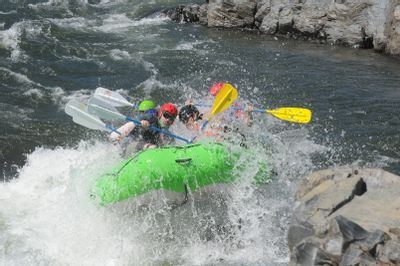River Classifications

The International Scale of River Difficulty is a rating system created by the American Whitewater Association as a means of comparing and evaluating the technical difficulty of rivers throughout the world. While this system provides a good general understanding of the risks and skill level inherent to a certain rapid or stretch of river, it is very much subjective and open to interpretation. Temperature, remoteness of location, and water level can impact the difficulty of a river. The following classifications are paraphrased from the Safety Code of American Whitewater (2005).
Class I (Easy)
Fast-moving water with small waves and few obstructions, all obvious and easily missed with little training. Easy self-rescue.
Class II (Novice)
Straightforward rapids with wide, clear channels that are evident without scouting. While occasional maneuvering may be required, rocks and medium-sized waves are easily missed by trained paddlers. Easy self-rescue.
Class III (Intermediate)
Rapids with moderate, irregular waves may be difficult to avoid. Complex maneuvers in fast current and good boat control in tight passages or around ledges are required; holes or strainers may be present but are easily avoided. Strong eddies and powerful current effects can be found, particularly on large-volume rivers. Scouting is advisable for inexperienced parties. While self-rescue is usually easy, group assistance may be required to avoid long swims.
Class IV (Advanced)
Intense, powerful, and predictable rapids requiring precise boat handling and fast, reliable eddy turns. Depending on the character of the river, it may feature large, unavoidable waves and holes or constricted passages demanding fast maneuvers under pressure. Rapids may require “must-make” moves above dangerous hazards. Scouting may be necessary the first time down. Self-rescue is difficult, and group assistance for rescue will require practiced skills. A strong roll is highly recommended.
Class V (Expert)
Extremely long, obstructed, or violent rapids with considerable risk exposure. Drops may contain large, unavoidable waves and holes or steep, congested chutes with complex routes. Rapids may continue for long distances between pools, demanding a high level of fitness. Eddies may be small, turbulent, difficult to reach, or non-existent. Scouting is recommended and may be difficult. Swims are dangerous, and rescue is often difficult even for experts. A reliable roll, proper equipment, extensive experience, and practiced rescue skills are essential.
Class VI (Extreme and Exploratory Rapids)
These runs have almost never been attempted and exemplify the extremes of difficulty, unpredictability, and danger. The consequences of errors are very severe and rescue may be impossible. For teams of experts only, at favorable water levels, after close personal inspection and taking all precautions.
Thank you to Melissa at California Watersport Collective for this article.





